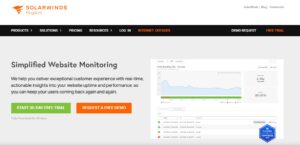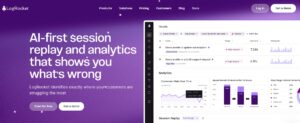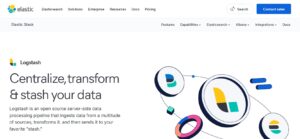Komodor is a Kubernetes-native troubleshooting tool known for simplifying complex Kubernetes debugging through clear visualization and smart event timelines that helps correlate events, logs, and deployments for faster incident resolution. But as 76% of organizations now prioritize OpenTelemetry adoption, teams are moving toward tools with full MELT observability—something Komodor lacks. It also doesn’t support RUM, control costs at scale, and thus making DevOps teams to seek alternatives.
CubeAPM is the best alternative to Komodor, offering full MELT observability, native OpenTelemetry support, and self-hosting, an extensive integration ecosystem(800+ integrations)—features Komodor lacks. With smart sampling and flat pricing($0.15/GB), it serves as the best alternative delivering key APM features at 60-70% lower cost
In this article, we’ll explore the top 7 Komodor alternatives that offer deeper observability, native OTEL support, self-hosting options, and more predictable pricing for growing teams.
Top 7 Komodor Alternatives
- CubeAPM
- Dynatrace
- Honeycomb
- Middleware
- Splunk Appdynamics
- Datadog
- New Relic
Table of Contents
ToggleWhy Look for Komodor Alternatives?
1. No Native APM, RUM, or Full MELT Support
Komodor focuses primarily on Kubernetes events, pod logs, and configurations. However, it lacks support for distributed tracing (APM), Real User Monitoring (RUM), and synthetic checks—key components of full-stack observability. As teams demand a MELT-native approach, Komodor’s feature set feels limited.
2. No OpenTelemetry Ingestion or Compatibility
OpenTelemetry is rapidly becoming the industry standard for observability pipelines. Komodor does not offer native OTEL collection, processing, or visualization capabilities—limiting its integration with modern telemetry stacks.
3. Steep Learning Curve
While Komodor is a strong platform for Kubernetes-native troubleshooting, its UI and workflows are designed with experienced DevOps teams in mind. For users unfamiliar with Kubernetes concepts like pods, deployments, and event streams, onboarding can be slow and frustrating. This knowledge gap often delays incident resolution during early adoption and increases dependency on more experienced team members.
“Komodor is a good platform. However, it may be complex for new users who had never worked with Kubernetes before.” — G2 Reviewer
“it’s still very technically devOps oriented, so it requires some deep knowledge in kubernetes to implement & integrate.” — G2 Reviewer
4. Overwhelming UI
Komodor’s interface presents a dense stream of logs, events, and deployment data—all valuable, but often too much at once. For new or lean teams, the information overload can slow down triage instead of speeding it up. Additionally, the platform offers limited flexibility in tailoring alerts to specific workflows, which can lead to noise and missed signals in high-velocity environments.
“The interface looks overflown with a lot of information. Additionally, I would prefer to see more customized alerts and notifications to adjust with my team’s needs.” — G2 Reviewer
5. Rising Costs for Mid-sized Teams
While Komodor delivers solid value for Kubernetes-centric environments, its usage-based pricing can quickly add up for smaller teams or startups operating on tight budgets. Without clear tiering or cost controls, even moderate-scale deployments may face bills that outweigh the platform’s feature set for early-stage use cases.
“Finally, the price is a bit high for small teams and startup companies.” — G2 Reviewer
6. Limited Integration with Third-party Tooling
Komodor integrates with a handful of CI/CD and alerting systems, but lacks native compatibility with common monitoring agents like Prometheus, OpenTelemetry Collector, or Elastic Beats. This limits its flexibility in hybrid observability setups.
Criteria for Suggesting Komodor Alternatives
To ensure fair and useful recommendations, we considered tools that meet at least four out of these six evaluation criteria:
1. OpenTelemetry-Native Support
Tools should natively ingest, visualize, and route OTEL-formatted telemetry—logs, metrics, traces, and events.
2. Full MELT Coverage (Metrics, Events, Logs, Traces)
The platform should provide out-of-the-box support for all four pillars of observability, ideally with RUM and synthetic monitoring.
3. Self-Hosting and Data Locality Options
Alternatives must offer either fully self-hosted deployment or hybrid models for teams that prioritize compliance and data control.
4. Cost Transparency and Predictable Billing
Tools with opaque usage-based pricing or heavy egress fees were deprioritized. We considered total cost for a 10TB/month ingestion workload and 100+ hosts.
5. Sampling Intelligence and Storage Efficiency
Advanced tools apply smart trace sampling to retain high-value data (e.g., traces with errors or latency) while keeping costs low.
6. Fast, Responsive Support (Not Just Email)
We favored platforms that offer Slack, chat, or dedicated dev support channels with fast SLAs, not just email-based tickets with 3-day turnarounds.
Komodor Overview
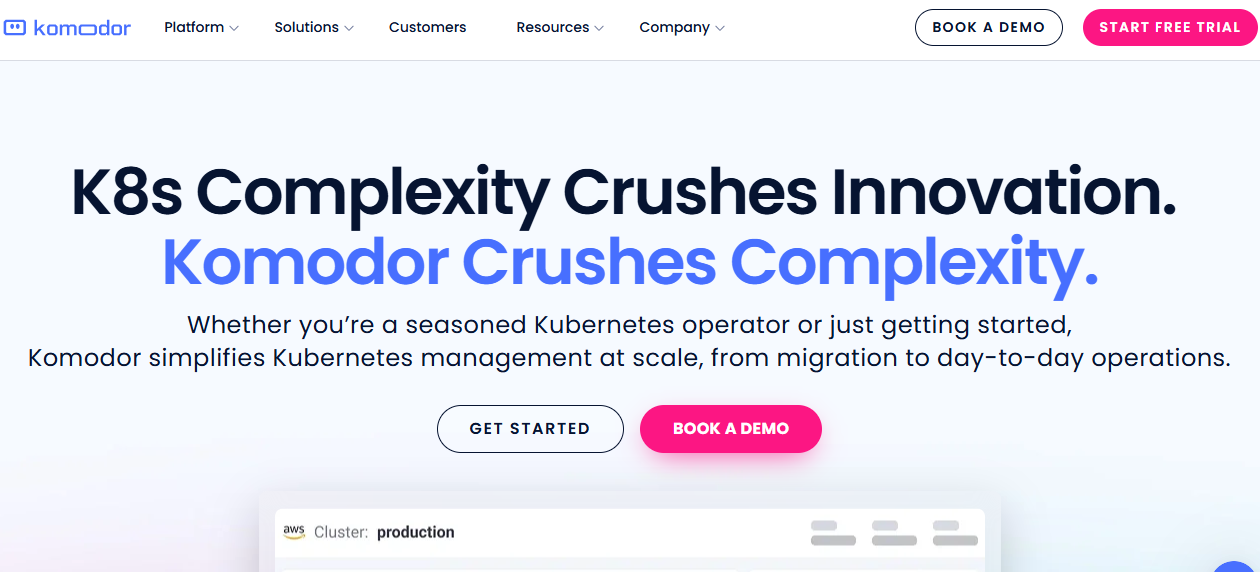
Known for:
Komodor is best known as a Kubernetes-native troubleshooting and incident response platform. It provides a centralized, timeline-based view of everything happening in your cluster—deployments, config changes, alerts, and service health—helping teams quickly identify what changed and why an issue occurred. It’s widely used by SRE and DevOps teams managing multi-cluster, microservices environments.
Standout Features:
- Timeline View
Visualizes real-time and historical deployments, alerts, and code/configuration changes across services in a single timeline.
- Service Dependency Mapping
Automatically maps inter-service relationships, making it easier to understand the upstream/downstream impact of failures.
- Slack and CI/CD Integrations
Integrates seamlessly with collaboration and automation tools, making incident workflows more efficient.
Key Features:
- Change Intelligence
Tracks every deployment, config update, and error across clusters, displaying detailed diffs for easy rollback or root-cause diagnosis.
- Service Health Dashboards
Provides real-time visibility into pod status, service health, and cluster activity without needing to run kubectl manually.
- Log and Event Correlation
Allows users to overlay logs and Kubernetes events with deployments and alerts for quick troubleshooting.
Pros:
- Faster Incident Resolution: Teams report significantly lower mean time to detect and resolve issues thanks to Komodor’s centralized event timeline and intuitive UI.
- Unified Kubernetes Visibility: Replaces multiple kubectl and logging tool hops with one visual, searchable console.
- Enhanced Collaboration: Integration with tools like Slack streamlines alerting and incident handling across distributed teams.
Cons:
- Limited Observability Scope, Komodor does not support APM, real user monitoring (RUM)
- No OTEL Support, It does not integrate natively with OpenTelemetry
- SaaS-only Deployment
- Limited Customization
Best for:
Komodor is ideal for platform engineering, DevOps, and SRE teams operating Kubernetes-based microservices. It works best in environments where fast change tracking and incident triage are more critical than deep telemetry analysis or end-to-end tracing. It’s especially useful for teams without existing observability pipelines who need quick operational visibility into Kubernetes behavior.
Pricing & Customer Reviews:
- Free tier: Available with limited features for small teams
- Paid:
- Teams: Custom pricing, 50 Nodes, 25 Users;
- Enterprise:Custom pricing, Unlimited Users
- Rating: 4.5/5 (G2)
Top 7 Komodor Alternatives
1. CubeAPM

Known for:
Full-stack OpenTelemetry-native observability platform offering APM, logs, metrics, RUM, synthetics, and error tracking with flat pricing and high-performance ingestion.
Key Features:
- Smart Trace Sampling
Dynamically retains traces with latency spikes or error events, reducing storage cost by over 70%
- Full MELT Coverage
Includes distributed tracing, infrastructure metrics, log management, real user monitoring, synthetics, and error tracking
- Self-Hosted or Cloud
Offers both SaaS and on-premises deployment options for teams needing data sovereignty or compliance flexibility
- OpenTelemetry-First Design
Seamlessly integrates with OTEL Collector and supports native OTEL pipelines
- High Compatibility
Compatible with Datadog, Prometheus, New Relic, and Elastic agents
Standout Features:
- Flat-Rate Pricing: Predictable billing regardless of data volume or user count
- Real-Time Slack/WhatsApp Support: Direct access to core engineers with minute-level TAT
- Compliance Ready: Data stays within your cloud for low latency and compliance with data localization laws
Pros:
- 60–70% cheaper than traditional APMs
- Extensive integrations ecosystem, 800+ integrations
- No vendor lock-in with OTEL and Prometheus support
- Built for both cloud-native and air-gapped environments
- Fast ingestion, low latency, and unlimited retention
Cons:
- Not suited for teams looking for off-prem solutions
- Strictly an observability platform and does not support cloud security management
Best for:
Engineering teams seeking a scalable, OpenTelemetry-native observability suite with predictable pricing, fast support, and flexible deployment options.
Pricing & Customer Reviews:
- Free tier: Available on request for startups and open-source projects
- Paid: Starts at $0.15/GB for ingestion, $0.01/GB for data transfer, and $0.02/GB for infra; no per-user or per-host fees
- Rating: 4.7/5 (G2)
CubeAPM vs Komodor:
While Komodor focuses solely on Kubernetes troubleshooting, CubeAPM delivers full-stack observability—including MELT telemetry, OTEL-native pipelines, and self-hosting. For teams needing broader coverage, compliance flexibility, and cost predictability, CubeAPM is a more complete and future-ready alternative.
2. Dynatrace
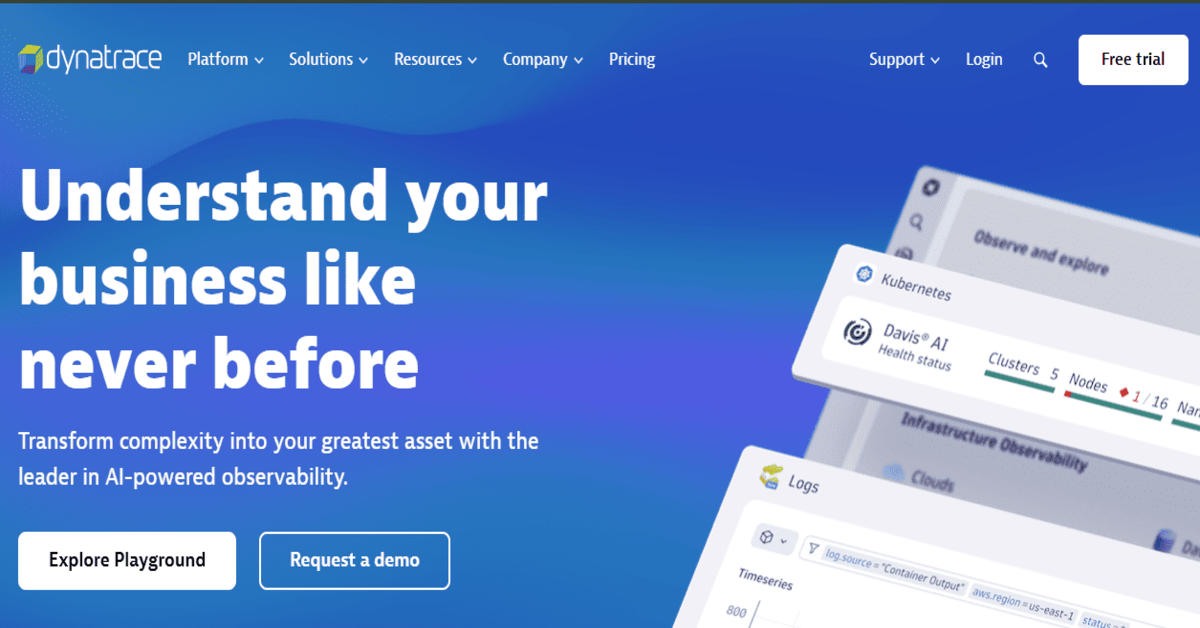
Known for:
Dynatrace is an AI-driven observability and application performance monitoring platform designed for large-scale enterprises, known for deep automation and full-stack dependency mapping.
Key Features:
- Davis AI Engine
Built-in AI engine automates anomaly detection, RCA, and impact analysis across services and infrastructure
- Code-Level Visibility
Deep tracing into Java, .NET, Node.js, and PHP with automated root cause analysis
- Full-Stack Context
Auto-discovers services, containers, and infrastructure with real-time topology mapping
- Cloud-Native Support
Integrates with Kubernetes, OpenShift, AWS, Azure, GCP, and hybrid environments
- Smartscape & PurePath
Service maps and distributed traces that capture end-to-end user requests automatically
Standout Features:
- Autonomous Cloud Monitoring
Self-discovering agents that auto-instrument new services as they scale
- Business Analytics Integration
Ties observability data to digital experience, conversions, and SLAs
- Grazie Workflow Engine
Automates remediation and alerting pipelines across toolchains
Pros:
- Highly automated setup with minimal manual configuration
- Extremely detailed service dependency maps
- Reliable root-cause analysis with AI-powered suggestions
- Suited for highly dynamic and complex environments
Cons:
- Premium pricing, often higher than competitors
- Requires training to fully leverage advanced capabilities
- Complex pricing model with multiple layers (Davis units, host units, sessions)
Best for:
Large enterprises managing microservices at scale who need automated observability, high fidelity traces, and proactive alerting without manual tuning.
Pricing & Customer Reviews:
- Free tier: 15-day trial with full platform access
- Paid:$0.08/hour per 8 GiB host (~$57.60/host/month)
- Rating: 4.5/5 (G2)
Dynatrace vs Komodor:
Dynatrace provides far deeper visibility and automation than Komodor, covering full-stack telemetry, AI-powered root cause analysis, and service maps. However, it comes at a significantly higher cost and complexity. Komodor is better for quick Kubernetes-only visibility, but Dynatrace is ideal for enterprise-wide observability automation.
3. Honeycomb
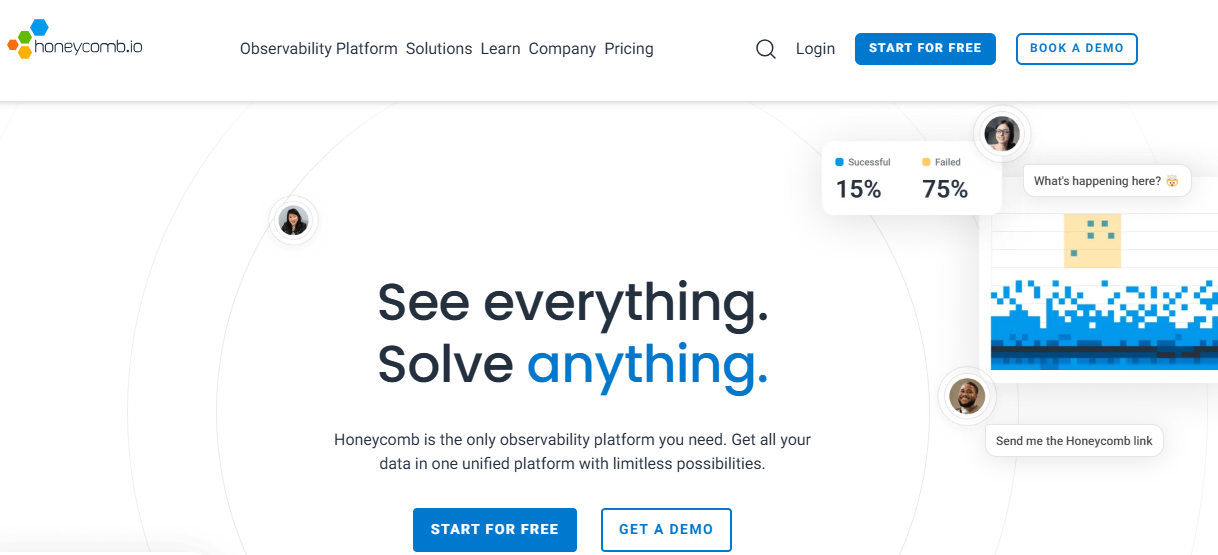
Known for:
An observability platform purpose-built for high-cardinality, event-based debugging and performance analysis, particularly in distributed systems and modern microservices environments.
Key Features:
- Event-Based Telemetry: Accepts structured events instead of traditional metrics for more granular debugging
- Columnar Storage Engine: Allows high-speed querying across billions of events with rich dimensions
- BubbleUp Debugging: Highlights outlier patterns and lets users drill down into problematic subsets instantly
- OpenTelemetry Native: Offers native OTEL support and SDKs, with built-in OTLP ingestion
- Service Maps & Traces: Visualizes spans, traces, and relationships across services in real time
Standout Features:
- High-Cardinality Querying: Supports queries across wide dimensions like user ID, endpoint, error type without pre-aggregation
- BubbleUp: Automatically detects anomalies in trace sets and surfaces the contributing fields
- Modern UX: Extremely fast query builder with interactive visual feedback during exploration
Pros:
- Best-in-class performance for debugging complex distributed systems
- Powerful for SREs who prefer deep, trace-first exploration over dashboards
- Built-in support for OpenTelemetry with fast ingestion
- Ideal for identifying patterns in large datasets (e.g., spike analysis)
Cons:
- Not a full MELT platform — lacks traditional metrics dashboarding, logs, synthetics, and infra visibility
- Query-first approach may feel unfamiliar or too raw for teams used to dashboards
- Can be expensive for large volumes of high-cardinality data
Best for:
Engineering teams with mature observability practices, especially those operating large-scale microservices who want to debug production using traces and rich dimensions—not just metrics.
Pricing & Customer Reviews:
- Pricing:
- Free plan includes 20 million events/month.
- Paid plans: $130/month for 100M events
- Traces: event-based billing
- Metric support via derived columns
- Tail-based sampling included
- Rating: 4.6/5 (G2)
Honeycomb vs Komodor:
Honeycomb excels in high-cardinality debugging and trace analysis, offering deeper visibility into distributed systems than Komodor. However, it lacks MELT coverage and Kubernetes-native service views. Komodor is easier for infra teams, while Honeycomb is better for engineering-heavy teams doing deep production debugging.
4. Middleware
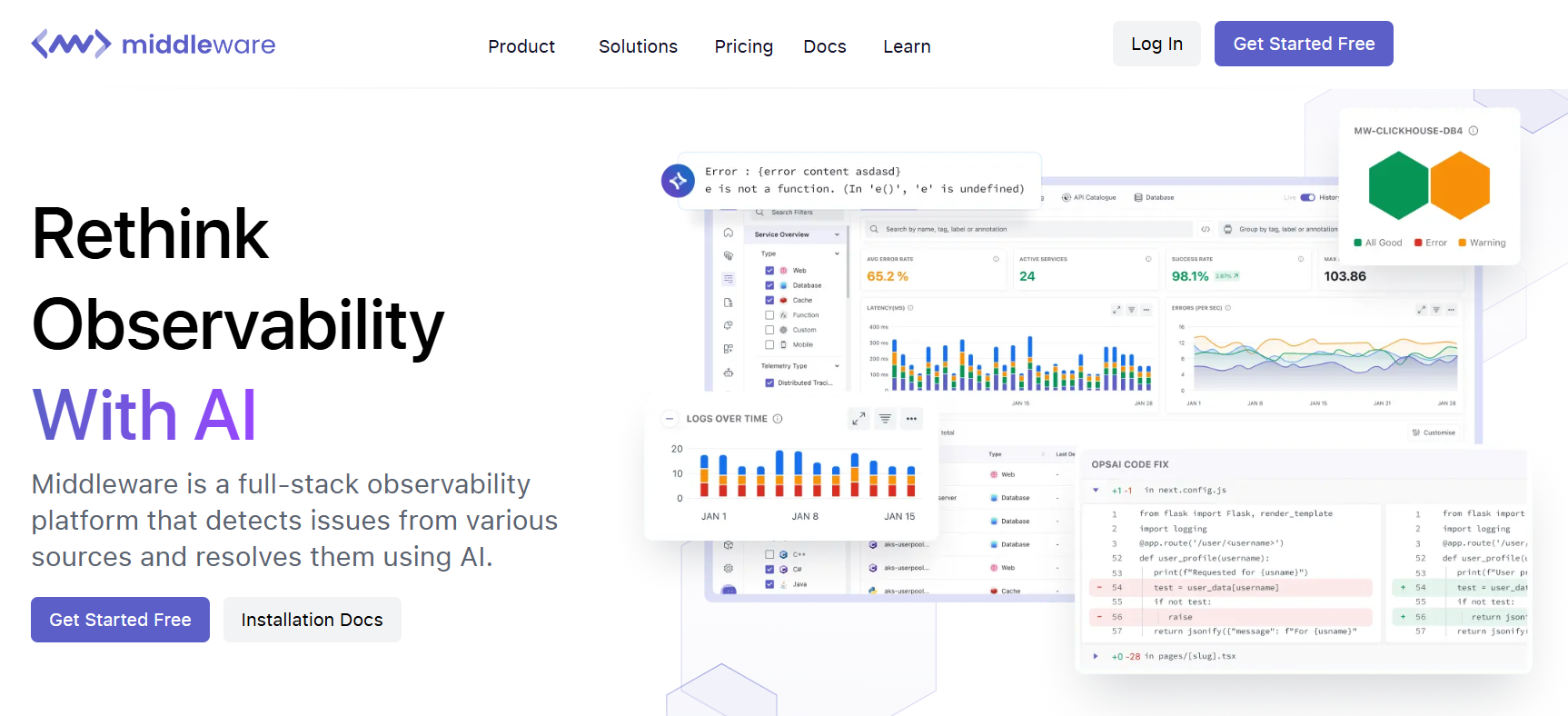
Known for:
A lightweight and cost-effective observability platform focused on performance monitoring, infrastructure metrics, and application health—especially for fast-growing teams needing simple setup and fast insights.
Key Features:
- APM & Tracing: Offers performance monitoring for APIs, services, and backend systems with built-in transaction tracing
- Real User Monitoring (RUM): Tracks frontend performance, Core Web Vitals, and user behavior metrics in real time
- Infrastructure Monitoring: Agent-based monitoring for servers, containers, and VMs with resource usage breakdowns
- Log Collection: Centralized logging for event aggregation and error troubleshooting
- Alerts & Anomaly Detection: Threshold-based and rule-based alerts with Slack and email integration
Standout Features:
- All-in-One UI: Combines metrics, logs, traces, and RUM in a single, accessible dashboard
- Quick Deployment: Auto-detection of services and infra components for quick onboarding
- Cost Visibility: Transparent pricing with minimal billing surprises—ideal for startups and lean teams
Pros:
- Easy to deploy and scale without dedicated observability staff
- Affordable for small and mid-sized teams
- Covers most key MELT components out-of-the-box
- Clean UI with minimal learning curve
Cons:
- Lacks support for OpenTelemetry and vendor-neutral pipelines
- Not built for high-scale or complex microservices tracing
- Limited advanced analytics or long-term retention features
Best for:
Startups and SMBs that need simple, affordable observability across app performance, infrastructure, and frontend UX—without heavy customization or complex setup.
Pricing & Customer Reviews:
- Pricing
- Free: upto 100GB data, unlimited users, 14-day retention
- Pay as you go: $0.3 GB of metrics, logs, traces; 30-day retention.
- Custom pricing
- Rating: 4.7/5 (G2)
Middleware vs Komodor:
Middleware offers broader MELT coverage than Komodor—covering APM, logs, RUM, and infra—at a far lower cost. However, it lacks Kubernetes-native troubleshooting and OTEL support. Komodor is better for Kubernetes triage, while Middleware is ideal for lean teams needing full-stack visibility fast.
5. Splunk AppDynamics

Known for:
Splunk AppDynamics is an enterprise-grade application performance monitoring and infrastructure visibility platform, now part of the Cisco + Splunk ecosystem. Known for deep code-level tracing, business transaction monitoring, and real-time infrastructure correlation.
Key Features:
- Application Performance Monitoring (APM): Tracks every business transaction across microservices with deep method-level tracing
- Infrastructure Monitoring: Correlates application behavior with CPU, memory, disk, and network metrics
- Business IQ Dashboards: Connects application metrics with business KPIs like conversions, revenue, or cart abandonment
- Alerting & Anomaly Detection: Baseline-based alerting with historical comparison and health rules
- Hybrid & Multi-Cloud Support: Deployable on-premises, SaaS, or hybrid environments with deep integrations for AWS, Azure, GCP
Standout Features:
- Business Transaction Monitoring: Visualizes and tracks key user workflows across the entire backend stack
- Dynamic Baselines: Auto-learns normal behavior patterns and detects anomalies in real time
- Tie-in with Splunk: Offers strong downstream analytics for logs and events via Splunk integrations
Pros:
- Rich visualizations and performance correlation
- Granular tracing down to database calls and async tasks
- Business and technical users can share common dashboards
- Flexible deployment across cloud and on-prem environments
Cons:
- Pricing is complex and enterprise-focused
- High learning curve for full platform adoption
- No native OpenTelemetry ingestion (requires translation or custom integration)
- Limited coverage for modern trace sampling or log cost control
Best for:
Large enterprises that prioritize performance monitoring tied to business outcomes, and require deep backend tracing with strong compliance and hybrid deployment support.
Pricing & Customer Reviews:
- Free tier: No public free tier; trials available on request
- Paid:Ranges $6/month-$50/host/month for APM, billed annually
- Rating: 4.3/5 (G2)
Splunk AppDynamics vs Komodor:
Splunk AppDynamics offers far deeper backend tracing, business KPI correlation, and hybrid deployment flexibility than Komodor. However, it lacks OTEL-native support and is significantly more complex to operate. Komodor remains simpler and more Kubernetes-specific, while AppDynamics is suited for enterprises needing detailed performance analytics tied to business impact.
6. Datadog

Known for:
Datadog is widely adopted observability platform offering end-to-end telemetry monitoring—spanning APM, infrastructure, logs, synthetics, RUM, and security analytics—in one interface.
Key Features:
- Comprehensive Telemetry Coverage: Supports logs, metrics, traces, synthetics, RUM, and security events across cloud and hybrid environments
- Dashboards and Correlation: Unified UI to correlate different telemetry types with drag-and-drop dashboards
- Massive Integration Ecosystem:900+ built-in integrations with cloud providers, runtimes, databases, containers, and orchestration platforms
- Live Container and Network Monitoring: Real-time service maps and flame graphs with live container metrics
- Security Monitoring Add-on: Optional features for threat detection, posture management, and attack surface analysis
Standout Features:
- Unified Observability + Security: Allows teams to monitor infrastructure and application security in a single tool
- Auto-Instrumentation Support: Easy setup with SDKs and auto-instrumentation for many languages
- Extensive Marketplace: Pre-built widgets and dashboards make it easy to extend and customize views
Pros:
- Industry-leading support for cloud-native, hybrid, and multi-cloud environments
- Mature APM with deep tracing capabilities and runtime visibility
- Strong visualizations and collaboration features
- Scales well for large enterprises
Cons:
- Opaque and unpredictable billing across telemetry types (hosts, logs, synthetic runs, user sessions, traces)
- Sudden cost spikes due to overages, unplanned usage, or unmonitored services
- Requires expert setup and tuning to manage cost and performance
- Email-only support at lower tiers with delayed SLAs
Best for:
Large organizations with mature DevOps/SRE practices and enterprise budgets, looking for a one-stop platform that blends observability and security at scale.
Pricing & Customer Reviews:
- Free tier: Basic agent-based infrastructure monitoring for up to 5 hosts
- Paid: APM starts at $31/host/month, infra at $15/host/month, logs from $0.10/GB ingested, RUM/Synthetics billed per session/run
- Rating: 4.3/5 (G2)
Datadog vs Komodor:
Datadog offers a far broader observability feature set than Komodor, covering the full MELT stack and security monitoring. However, its complex pricing model and surprise billing make it harder to manage at scale. Komodor is easier to use for Kubernetes-specific issues, but Datadog wins on depth—if you can afford it.
7. New Relic

Known for:
New Relic is a full-stack observability platform offering monitoring for applications, infrastructure, logs, browser performance, synthetics, and more—all unified under a single UI with a usage-based pricing model.
Key Features:
- APM & Distributed Tracing: Tracks application performance down to the line of code, with support for multiple languages
- Logs, Metrics, Traces in One UI: Centralized observability with a unified query language (NRQL)
- Infrastructure Monitoring: Monitors hosts, containers, and Kubernetes clusters with real-time telemetry
- Browser & Mobile Monitoring: Real user monitoring with Core Web Vitals and frontend performance data
- Synthetics & Alerts: Proactive checks on APIs and sites, with dynamic alert policies and anomaly detection
Standout Features:
- All-in-One Platform: Offers one of the most complete MELT stacks out of the box
- OpenTelemetry Support: Ingests OTEL traces and metrics, though native OTEL usage is not as seamless as OTEL-first platforms
- Custom Dashboards & NRQL: Flexible dashboarding using their proprietary query language
Pros:
- Covers nearly every telemetry type in one platform
- Clean UI with strong correlation between metrics and traces
- Marketplace with 500+ quickstart integrations
- Competitive for teams needing quick onboarding
Cons:
- Usage-based pricing can spike costs rapidly at scale
- Retention policies and query caps vary by plan
- Data is stored on New Relic’s cloud—raises compliance concerns for some regions
- Complex to predict costs for growing teams
Best for:
Teams looking for a quick-start, all-in-one observability suite that supports multiple telemetry types with minimal initial setup—especially for startups and mid-sized teams comfortable with usage-based pricing.
Pricing & Customer Reviews:
- Free tier: 100 GB/month of data ingest with 30-day retention
- Paid: Starts at $0.30–$0.50/GB ingested; user seats are priced separately (~$400/user/month for full access)
- Rating: 4.4/5 (G2)
New Relic vs Komodor:
New Relic delivers much broader observability than Komodor—including APM, RUM, logs, infra, and synthetics—but comes with a steep usage-based pricing model and less control over data localization. Komodor is better for simple Kubernetes timelines, while New Relic is more suited for full-stack teams ready to manage cost complexity.
Conclusion
While Komodor offers valuable Kubernetes-native troubleshooting capabilities, it falls short when it comes to full-stack observability, OpenTelemetry support, and flexible deployment models. As modern teams increasingly demand MELT coverage, cost transparency, and compliance-ready architectures, alternatives like CubeAPM, Datadog, and New Relic present compelling options—each catering to different scales and priorities.
Suppose you’re looking for a lightweight, OTEL-native platform with full MELT support, predictable pricing, and the option to self-host. In that case, CubeAPM stands out as the most complete and cost-efficient alternative to Komodor. For larger enterprises, tools like Dynatrace and Splunk AppDynamics bring powerful automation and deep tracing capabilities, while Honeycomb and Middleware offer unique strengths for debugging and startup-friendly observability.
Ultimately, the right Komodor alternative depends on your team’s scale, tech stack, compliance needs, and budget flexibility. This guide gives you a clear roadmap to choose a solution that’s built for the future of observability.

